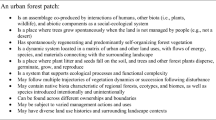Abstract
A standard campsite model is proposed and then manipulated to examine the influence of individual variables on amount of vegetation loss. Amount of impact is influenced by amount of use, vegetation fragility, vegetation density, and the degree to which activities are concentrated spatially on the site. Degree of concentration also influences the importance of the other explanatory variables. Amount of use and vegetation fragility are equally important determinants of impact and are most influential where activity concentration is low. The curvilinear relationship between amount of use and amount of impact can be explained by the tendency for activities to become increasingly concentrated as amount of use increases. This relationship should not vary with regional or environmental characteristics except where these influence degree of activity concentration.
Similar content being viewed by others
Literature Cited
Cole, D. N. 1982. Wilderness campsite impacts effect of amount of use. USDA Forest Service Research Papert INT-284. Intermountain Forest and Range Experiment Station, Ogden, Utah, 34 pp.
Cole, D. N. 1983. Campsite conditions in the Bob Marshall Wilderness, Montana. USDA Forest Service Research Paper INT-312. Intermountain Forest and Range Experiment Station, Ogden, Utah, 18 pp.
Cole, D. N. 1987a. Research on soil and vegetation in wilderness: A state-of-knowledge review. Pages 135–177in R. C. Lucas (comp.), Proceedings, national wilderness research conference: Issues, state-of-knowledge, future directions. USDA Forest Service General Technical Report INT-220. Intermountain Research Station, Ogden, Utah.
Cole, D. N. 1987b. Effects of three seasons of experimental trampling on five montane forest communities and a grassland in western Montana, USA.Biological Conservation 40:219–244.
Cole, D. N. 1989. Area of vegetation loss: A new index of campsite impact. USDA Forest Service Research Note INT-389. Intermountain Research Station, Ogden, Utah, 5 pp.
Cole, D. N., and J. L. Marion. 1988. Recreation impacts in some riparian forests of the eastern United States.Environmental Management 12:99–107.
Frissell, S. S., Jr., and D. P. Duncan. 1965. Campsite preference and deterioration in the Quetico-Superior canoe country.Journal of Forestry 65:256–260.
Lull, H. W. 1959. Soil compaction on forest and range lands. USDA Forest Service Miscellaneous Publication 768. Washington, DC, 33 pp.
Montgomery, P. H., and F. C. Edminster. 1966. Use of soil surveys in planning for recreation. Pages 104–112in L. J. Bartelli (ed.), Soil surveys and land use planning. Soil Science Society of America and American Society of Agronomy, Madison, Wisconsin.
Author information
Authors and Affiliations
Rights and permissions
About this article
Cite this article
Cole, D.N. Modeling wilderness campsites: Factors that influence amount of impact. Environmental Management 16, 255–264 (1992). https://doi.org/10.1007/BF02393831
Issue Date:
DOI: https://doi.org/10.1007/BF02393831




